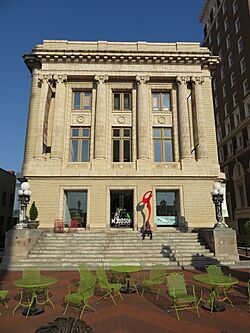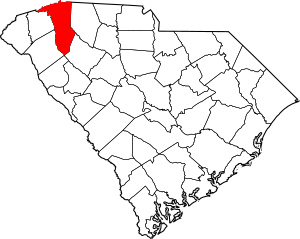Greenville County, South Carolina facts for kids
Quick facts for kids
Greenville County
|
|||
|---|---|---|---|

Old Greenville County Courthouse
|
|||
|
|||
| Motto(s):
"Unrivaled Quality Of Life"
|
|||

Location within the U.S. state of South Carolina
|
|||
 South Carolina's location within the U.S. |
|||
| Country | |||
| State | |||
| Founded | 1786 | ||
| Named for | Nathanael Greene | ||
| Seat | Greenville | ||
| Largest community | Greenville | ||
| Area | |||
| • Total | 795.57 sq mi (2,060.5 km2) | ||
| • Land | 785.93 sq mi (2,035.5 km2) | ||
| • Water | 9.64 sq mi (25.0 km2) 1.21% | ||
| Population
(2020)
|
|||
| • Total | 525,534 | ||
| • Estimate
(2023)
|
558,036 |
||
| • Density | 660.575/sq mi (255.0496/km2) | ||
| Time zone | UTC−5 (Eastern) | ||
| • Summer (DST) | UTC−4 (EDT) | ||
| Congressional districts | 3rd, 4th | ||
Greenville County (/ˈɡriːnvɪl/ GREEN-vil; locally /ˈɡriːnvəl/ GREEN-vəl) is located in the U.S. state of South Carolina. As of the 2020 census, the population was 525,534, making it the most populous county in the state. Its county seat is Greenville. The county is also home to the Greenville County School District, the largest school system in South Carolina. Greenville County is the most populous county in Upstate South Carolina as well as the state. It is the central county of the Greenville-Anderson-Greer, SC Metropolitan Statistical Area, which in turn is part of the Greenville-Spartanburg-Anderson, SC Combined Statistical Area.
History
18th and 19th centuries
In 1786, due to population growth in Ninety-Six District and the victory of the American Whigs over the British and their colonial Tory and Cherokee allies, the state legislature formed Greenville County (originally spelled Greeneville), named for General Nathanael Greene, the hero of the American southern campaign. Greenville County was the first county created in the overarching Ninety-Six District, but from 1791 to 1798, both neighboring Pendleton County (the other county formed from Cherokee territory in northwestern Ninety-Six District) and it were part of the new overarching Washington District. From 1798 to 1800, it was part of the short-lived overarching Pendleton District. In 1798, all counties were reidentified as "elective districts" to be effective on January 1, 1800; thereafter, the Greenville District was no longer part of Pendleton District. In 1868, the districts were converted back to counties. After the Civil War ended in the 1860s, former slaves gained freedom, the textile industry grew quickly, and cotton farming expanded in the county. Completion of the Southern Railway in 1893 joined the local economy with the rest of the nation.
20th century
The Atlantic Coast Line Railroad's consolidation into the 1900s further linked the county with the national economy, and dozens of textile companies opened, with farm workers migrating to associated mill villages. World War I and creation of the Army National Guard's Camp Sevier in Taylors further increased the county's outside connections in the early 20th century. Duke's Mayonnaise was started in Greenville in 1917 and still has its company headquarters in the county.
World War II brought additional contracts for the textile industry in the 1940s. After the war ended, agriculture decreased and business leaders such as Charles E. Daniel and Roger Milliken pursued other industries to replace textiles. Donaldson Air Force Base was converted into an industrial air park (now Donaldson Center Airport) in the early 1960s, and Greenville–Spartanburg International Airport opened then as well.
The 1960s brought gradual racial desegregation until the county's whole school district was integrated in January 1970. Interstate highways I-85, I-185, and I-385 first crossed the county in the 1960s, promoting growth and better economic placement. The mid-1960s reapportionment of state legislative representation into equal-population election districts brought political change, with metropolitan counties such as Greenville gaining influence over rural counties. Greenville County politicians were elected as state house and senate leaders and as state governors (Richard Riley and Carroll A. Campbell Jr.) in the 1960s, 1970s, and 1980s.
Geography
According to the U.S. Census Bureau, the county has a total area of 795.57 square miles (2,060.5 km2), of which 785.93 square miles (2,035.5 km2) is land and 9.64 square miles (25.0 km2) (1.21%) is water.
State and local protected areas/sites
- Ashmore Heritage Preserve/Wildlife Management Area
- Bald Rock Heritage Preserve
- Belvue Springs Heritage Preserve
- Blackwell Heritage Preserve
- Blue Wall Preserve
- Bunched Arrowhead Heritage Preserve
- Caesars Head/Jones Gap
- Caesars Head State Park
- Cedar Falls Park
- Chestnut Ridge Heritage Preserve and Wildlife Management Area
- Clear Creek Heritage Preserve
- Conestee Nature Preserve
- Eva Russell Chandler Heritage Preserve/Wildlife Management Area
- Falls Park on the Reedy
- Greenville Zoo
- J. Verne Smith Park (Lake Robinson)
- Jones Gap State Park
- Mills Mill
- Mountain Bridge Wilderness Area
- Paris Mountain State Park
- Pleasant Valley Park
- Poinsett Bridge Heritage Preserve
- Tall Pines Wildlife Management Area
- Upcountry History Museum
- Watson-Cooper Heritage Preserve/Wildlife Management Area
Major water bodies
- Enoree River
- North Saluda Reservoir
- North Saluda River
- Reedy River
- Saluda River
- South Pacolet River
- South Saluda River
Adjacent counties
- Henderson County, North Carolina – north
- Polk County, North Carolina – northeast
- Spartanburg County – east
- Laurens County – southeast
- Abbeville County – south
- Anderson County – southwest
- Pickens County – west
- Transylvania County, North Carolina – northwest
Major highways
 I-85
I-85




 I-185 / I-185
I-185 / I-185 I-385
I-385 I-385 Bus.
I-385 Bus. US 25
US 25
 US 25 Conn.
US 25 Conn. US 29
US 29
 US 29 Conn. (Greenville)
US 29 Conn. (Greenville)
 US 29 Conn. (Wade Hampton)
US 29 Conn. (Wade Hampton) US 123
US 123 US 276
US 276

 US 276 Conn.
US 276 Conn. SC 11
SC 11 SC 14
SC 14


 SC 14 Truck
SC 14 Truck SC 20
SC 20 SC 86
SC 86 SC 101
SC 101


 SC 101 Truck
SC 101 Truck SC 124
SC 124 SC 146
SC 146 SC 183
SC 183 SC 253
SC 253 SC 288
SC 288 SC 290
SC 290


 SC 290 Truck
SC 290 Truck SC 291
SC 291 SC 417
SC 417 SC 418
SC 418
Major infrastructure
- Donaldson Center Airport
- Greenville Downtown Airport
- Greenville–Spartanburg International Airport (mostly in Spartanburg County)
- Greenville Station (Amtrak)
Demographics
| Historical population | |||
|---|---|---|---|
| Census | Pop. | %± | |
| 1790 | 6,503 | — | |
| 1800 | 11,504 | 76.9% | |
| 1810 | 13,133 | 14.2% | |
| 1820 | 14,530 | 10.6% | |
| 1830 | 16,476 | 13.4% | |
| 1840 | 17,839 | 8.3% | |
| 1850 | 20,156 | 13.0% | |
| 1860 | 21,892 | 8.6% | |
| 1870 | 22,262 | 1.7% | |
| 1880 | 37,496 | 68.4% | |
| 1890 | 44,310 | 18.2% | |
| 1900 | 53,490 | 20.7% | |
| 1910 | 68,377 | 27.8% | |
| 1920 | 88,498 | 29.4% | |
| 1930 | 117,009 | 32.2% | |
| 1940 | 136,580 | 16.7% | |
| 1950 | 168,152 | 23.1% | |
| 1960 | 209,776 | 24.8% | |
| 1970 | 240,546 | 14.7% | |
| 1980 | 287,913 | 19.7% | |
| 1990 | 320,167 | 11.2% | |
| 2000 | 379,616 | 18.6% | |
| 2010 | 451,225 | 18.9% | |
| 2020 | 525,534 | 16.5% | |
| 2023 (est.) | 558,036 | 23.7% | |
| U.S. Decennial Census 1790–1960 1900–1990 1990–2000 2010 2020 |
|||
2020 census
| Race | Num. | Perc. |
|---|---|---|
| White (non-Hispanic) | 343,897 | 65.44% |
| Black or African American (non-Hispanic) | 87,124 | 16.58% |
| Native American | 893 | 0.17% |
| Asian | 12,875 | 2.45% |
| Pacific Islander | 398 | 0.08% |
| Other/mixed | 22,322 | 4.25% |
| Hispanic or Latino | 58,025 | 11.04% |
As of the 2020 census, 525,534 people, 199,551 households, and 130,296 families were residing in the county.
2010 census
At the 2000 census, 451,225 people, 176,531 households, and 119,362 families were residing in the county. The population density was 574.7 inhabitants per square mile (221.9/km2). The 195,462 housing units had an average density of 249.0 per square mile (96.1/km2). The racial makeup of the county was 73.8% White, 18.1% African American, 2.0% Asian, 0.3% American Indian, 0.1% Pacific Islander, 3.9% from other races, and 1.9% from two or more races. Those of Hispanic or Latino origin made up 8.1% of the population. In terms of ancestry, 13.0% were American, 11.6% were German, 10.9% were English, and 10.7% were Irish.
Of the 176,531 households, 33.7% had children under 18 living with them, 49.7% were married couples living together, 13.5% had a female householder with no husband present, 32.4% were not families, and 27.0% were made up of individuals. The average household size was 2.49, and the average family size was 3.03. The median age was 37.2 years.
The median income for a household in the county was $46,830 and for a family was $59,043. Males had a median income of $45,752 versus $33,429 for females. The per capita income for the county was $25,931. About 10.8% of families and 14.1% of the population were below the poverty line, including 20.0% of those under age 18 and 9.1% of those age 65 or over.
Race and ethnicity
| Racial composition | 2010 | 2019 |
|---|---|---|
| White | 73.8% | 76.3% |
| Black | 18.1% | 18.4% |
| Asian | 2.0% | 2.7% |
| Native American | 0.3% | 0.5% |
| Native Hawaiian and other Pacific Islander |
0.1% | 0.1% |
| Two or more races | 1.9% | 2.0% |
| Other | 3.8% | 0.0% |
Ancestry
As of 2016, the largest self-reported ancestry groups in Greenville County were:
| Ancestry | Percent (2016) |
|---|---|
| English |
12.9% |
| German |
11.0% |
| Irish |
10.2% |
| American |
9.9% |
| Scotch-Irish |
3.1% |
| Italian |
3.1% |
| Scottish |
2.9% |
| French |
2.2% |
| Polish |
1.5% |
| Dutch |
1.2% |
| Welsh |
0.7% |
| Swedish |
0.7% |
| Norwegian |
0.6% |
Economy
CommunityWorks Federal Credit Union was chartered in 2014 to serve the residents of Greenville County. It is sponsored by CommunityWorks, Inc., a nonprofit community-development financial institution, and receives assistance from the United Way of Greenville County and the Hollingsworth Fund.
In 2022, the GDP of Greenville County was $40.6 billion (approx. $72,712 per capita). In chained 2017 dollars, it had a real GDP of $34.3 billion (approx. $61,507 per capita). From 2022 through 2024, the unemployment rate has fluctuated between 2.1-3.3% within the county.
Some of the largest employers in the county include Bon Secours, Charter Communications, GE Vernova, Lockheed Martin, Michelin, Prisma Health, Publix, TD Bank, the United States Postal Service, and Walmart.
| Industry | Employment Counts | Employment Percentage (%) | Average Annual Wage ($) |
|---|---|---|---|
| Accommodation and Food Services | 27,980 | 9.6 | 23,920 |
| Administrative and Support and Waste Management and Remediation Services | 28,877 | 9.9 | 42,848 |
| Agriculture, Forestry, Fishing and Hunting | 210 | 0.1 | 37,960 |
| Arts, Entertainment, and Recreation | 5,632 | 1.9 | 22,516 |
| Construction | 15,291 | 5.2 | 77,896 |
| Educational Services | 18,844 | 6.4 | 51,168 |
| Finance and Insurance | 12,361 | 4.2 | 80,756 |
| Health Care and Social Assistance | 43,180 | 14.8 | 67,756 |
| Information | 4,850 | 1.7 | 73,684 |
| Management of Companies and Enterprises | 6,100 | 2.1 | 93,548 |
| Manufacturing | 31,693 | 10.8 | 71,708 |
| Mining, Quarrying, and Oil and Gas Extraction | 81 | 0.0 | 87,256 |
| Other Services (except Public Administration) | 7,077 | 2.4 | 46,540 |
| Professional, Scientific, and Technical Services | 21,485 | 7.3 | 87,308 |
| Public Administration | 7,535 | 2.6 | 57,616 |
| Real Estate and Rental and Leasing | 4,143 | 1.4 | 58,500 |
| Retail Trade | 30,485 | 10.4 | 38,584 |
| Transportation and Warehousing | 11,422 | 3.9 | 59,436 |
| Utilities | 890 | 0.3 | 71,760 |
| Wholesale Trade | 14,230 | 4.9 | 83,096 |
| Total | 292,366 | 100.0% | 59,212 |
Education
School districts serving the county include:
- Anderson School District 2
- Greenville County School District
- Spartanburg County School District 1
Additionally, Greenville County has numerous public charter schools that are free to state residents.
The Greenville County Library System includes 11 libraries that provide meeting spaces, programs, books and other educational resources for county residents. The library system is managed by a board of trustees whose 11 members serve 4-year terms after appointment by the county council. Terms expire at the end of November in odd-numbered years, with half expiring every two years. In October 2023, after some prior controversy, the library board voted to remove all themed displays from its facilities except those pertaining to paid holidays.
Healthcare
The Greenville Memorial Hospital was formerly operated by the municipal government, with Greenville Health System being the operating authority. In 2016, Prisma Health began leasing the hospital and directly operating. The GHA is the portion of the Greenville Health System that still existed after the hospital transitioned into being operated by Prisma. The Greenville Health Authority (GHA) is the owner of the hospital facilities operated by Prisma. Members of the South Carolina Legislature select a majority of the seats of the board of directors of the GHA.
Communities
In the past, Greenville County was partitioned into townships. Their former names and boundaries were used for United States census counting purposes and census documentation through 1960, after which census counting divisions were used. The 2010 Census lists six cities and 16 census designated places that are fully or partially within Greenville County.
Cities
- Fountain Inn (partly in Laurens County)
- Greenville (county seat and largest community)
- Greer (partly in Spartanburg County)
- Mauldin
- Simpsonville
- Travelers Rest
Census-designated places
- Berea
- Caesars Head
- City View
- Conestee
- Dunean
- Five Forks
- Gantt
- Golden Grove
- Judson
- Parker
- Piedmont (partly in Anderson County)
- Sans Souci
- Slater-Marietta
- Taylors
- The Cliffs Valley
- Tigerville
- Wade Hampton
- Ware Place
- Welcome
Other unincorporated communities
See also
 In Spanish: Condado de Greenville para niños
In Spanish: Condado de Greenville para niños



